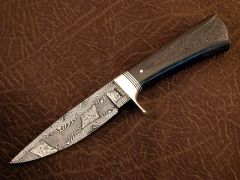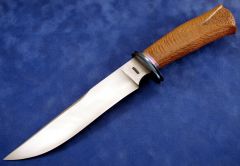-
Posts
90 -
Joined
-
Last visited
Contact Methods
-
Website URL
http://www.caffreyknives.net
Converted
-
Location
Great Falls, Montana, USA
-
Biography
Full time American Bladesmith Society Mastersmith, Retired USAF MSgt (22 years)
-
Interests
Outdoors(hunting/fishing), computers
-
Occupation
Full time Bladesmith
-

adhesives for knife handles
EdCaffreyMS replied to civilwarblacksmith's topic in Finish and Polish for Knives
The one thing that nobody has talked about is longevity. The whole reason that I started using AcraGlass is that after about 6-7 years into my knifemaking career, I had some knives come back, which had the handles loosening. A Makers we generally think about the short term, meaning that we focus on how well the adhesive will hold while the knife is being made and in our possession. When those knife came back to me, I did a ton of research, and found that through chemistry, the makers of many brands of epoxy design them so they only have a short shelf life, and automatically start breaking down at the 3-5 year point. If you think about it, they want you to buy more of their product....so building in a "use life" is in their best interests......but certainly not ours! Looking at various adhesives, I went with AcraGlass because of it's 10 year shelf life, and it's 50 year hold life. The West Systems is a close second with 5 year shelf life, and a 30 year hold life. Each of us has to decide whats important to us as makers. My goal is to never have to repair anything I make...ever. If your using something like Devcon epoxy, and your in this for the long haul, then expect to see those knives again....in about 4-6 years. The key is to NEVER skimp on any where you knives are concerned. Do it, and it will come back to haunt you later. -
Your likely not going to find any coating that can be used on steel, self applied, that will hold up for use on an eating utensil. The ideal route to take is to make the items out of a quality stainless steel. If these items are for use outside your immediate family, I would also think that the liability is going to be scary high with any coating. Its not going to stay on, and its only going to take someone getting sick or chipping/breaking a tooth from biting down on a chunk of the coating that has come off to ruin you. It's sad, but with the way the world is today, you gotta think about covering yourself and don't do anything that will get yourself in trouble.
-
My recommendation are the books by Jim Hrisoulas.... -The Complete Bladesmith -The Master Bladesmith -Pattern Welded Steel There are many other good references, both in books and on the net, but remember this.... Take everything you read, and everything your told, with a grain of salt, until you prove or disprove it for yourself. There are many subtleties in the art of Bladesmithing, and not everything works the same for everyone. Sometimes what might seem like very minor details, that might be left out of a printed text or even a verbal conversation, can make all the difference. That is why I mentioned taking things with a grain of salt. The biggest head start you can give yourself is to take some classes from an established Bladesmith. Working hand in hand with a knowledgeable individual will literally cut years off the learning curve.
-
Hi Eric! I don't know how familiar you are with stainless steels, but for the most part its going to require you owning a digitally controlled heat treat oven in order to do the job properly. Many of the time/temp cycles required are simply not achievable any other way. I have successfully heat treated S30V without one, but it was a very long experimenting process, and I wrecked a few hundred dollars worth of the steel before I figured it out. Crucible Service Center on the net provides a lot of good information in the area your seeking.
-
ONLY DC CURRENT!! About all you'll get out of trying to use 110v is hurt, and maybe burn the whole place down!! DON'T DO IT!
-
This is gona sound like a smart-ellic, but my suggestion is don't forge it. I spent nearly two years of the Bladesmithing career forging stainless steels. Nothing I found made me believe it was viable, and many things I found speak against it. The forging temp ranges for stainless steels are very narrow, and very specific to each type. Most are only a couple hundred degrees. Striking the steel above or below the proper temps will cause cracking or crumbling. Nearly all of the stainless steels are going to require you to have a computer controlled heat treating oven to achieve a good heat treat. Even with all that, it has been my experience that most stainless steels simply will not exhibit the same levels of toughness, and durability as carbon or simple alloy steels. That's not knocking anyone who uses stainless steels, just my opinion, based on 25 years of knifemaking experience.
-
I just realized that I'll miss this week's Friday night Knife Chat! I'll be heading out around noon on Friday to attend the Big Sky Hammer-In. Sorry for the late notice....just plain slipped my mind.
-
Since writing that, I have learned more, and have modified the way I do it. The method your speaking of works, but what I do now works better. Maybe the term "thermal cycling" might be more representative than "Normalizing". Anyway, heres what I now do, and am teaching to my students.... After you've completed forging, bring the steel to 1200-1300F, which in most cases, depending on your ambient light, will be a very dull blood red. Then allow the steel to cool in still air to below 800F. This is what I refer to as my "insurance policy" because doing so will heal any grain growth that occurred. In addition, it is also stress relieving the steel. I perform this cycle 3X, then go to non-magnetic for the annealing heat, and place the steel in vermiculite. Its basically doing the same things that I previously described, but just "better". Spectrographs have shown that the steel is achieving smaller grain size than most other methods I've had tested. I also perform the "thermal cycling" just prior to hardening a blade, and as with the other method, it will usually eliminate any warpage. To directly answer your question....Annealing will relieve stresses, but sometimes not all of the stress....and often times this will lead to warpage later on in the process. In my opinion, stress relieving steps are a must, and if you choose not to perform them, you may not experience probelms, but on the other hand you might......I would rather err on the side of caution, than fret about it after something has gone south.
-
The 2008 Blade Show is history. For me the show was a bit better than average. Just about everything I took that was sub-$1,000 sold, but anything over that figure seemed to get a lot of looks......then when the individual(s) saw the price tag, they shied away. One thing that I thought was kind of strange (at least for me) was that I received about a dozen emails the week prior to the show, asking if I would have any Progression Folders. I took two, and brought two back home. Never did see that first person who had emailed me asking about them. Thats OK though, they'll be up on the website later this week for sale. The crowd on Friday afternoon was much larger than what I've seen for the past few years. And Saturday about noon, the place was just packed. It did seem that many folks had specific destinations in mind, went there, and then took some time to wonder around. The JS and MS judging went like this: New Journeyman Smiths Fuad Accawi (Peck Award) Karl Andersen Ronald Boydston Dan Cassidy Carlton Hallenbeck Steven Kelly David Sylvester Brian Thie Daniel Warren New Master Smiths Russ Andrews Bill Burke Sean McIntyre (Hughes Award) J. Neilson James Saviano Henry Torres I was especially proud to see my friends Steve Kelly, Karl Anderson, Brian Thie, Bill Burke, J. Neilson, and Henry Torres achieve their ratings. I didn't spend a lot of time in "The Pit" this year, but changed my tactics and spent my evenings having dinner and sharing friendship with The Bybees' (Alpha Knife Supply), Steve and Melissa Kelly, and my good friend Jon Christensen. With only me to man the table, I didn't get around nearly as much as I would have liked to, and I know I missed a lot of folks I wanted to see. I did sneak away long enough to pick up a few supplies, and to be flabbergasted at the price of Fossil Ivory! I went to one suppliers table to check out some Fossil Ivory scales.....I found a decent pair that was 5" X 1 1/4" that had just some hints of green in them. When I looked at the price...it was $635!!! Some guy came over to me and said that they were having a 50% off sale on that price...... $317???!! I know I made him mad, but told him that he was smoking crack even at that price. In my opinion, the bottom line is that the economy, and the price of everything going up is impacting knife shows considerably. Some supplies were nearly double the cost of what they were last year, and folks were less eager to let go of their money for a knife. Nearly every person that came to my table tried to talk me down on price. I don't mind that, but its something that hasn't occurred all that often with me. Just one more sign of the times. In the end it was a good show for me, and I will certainly be there in 2009.
-
Just a reminder to everyone that I won't be here for Friday night knife chat this week. In about two hours I fly out for Atlanta, and the 2008 Blade Show. Hope to see many of you there! I'll be at table 9-0, so stop by and say Hi! I'll be back for next week's knife chat, the Lord willing. Have a great weekend!
-
Brazing can be done with an oxy/acty rig. The problems you run into with brazing is the temps required (1200F+), with these kind of temps you run a big risk of ruining the blades temper.......and the color of the braze material is going to be light to dark gold color depending on the specific braze you use, and extremely difficult to clean up. My recommendation it to use a low melt silver solder like "Stay-Brite", which only requires about 400F, and can be accomplished with a simple propane torch.
-
It can be soldered to steel, but "fusing" it (something like a forge weld) would be a difficult task....and may not be possible at all. Your dealing with a an iron based alloy (the steel) and non-iron based material (the mokume). The melting point of the mokume is considerably lower than the welding temp of the steel. I have never heard of it being done, and if it were, I would suspect that it would require very specialized equipment. Pinning, soldering, or attaching with screws are all options that would be far less labor intensive that attempting to "fuse" the two.
-
5160 is notoriously difficult to forge weld. If your planning on mixing it with mild steel, you won't have a very useful product by the time your done (provided its not full of cold shuts)..... In 5160 your only dealing with only .60% carbon.....even in an "as hardened" state, your not going to get much hardness. My personal opinion is not to waste your time forge welding 5160...... its a 50/50 gamble most of the time. Your best chances with forge welding come when you utilize two or more steels that are similar in expansion and contraction coefficients. Meaning that if the two (or more) steels you use in a billet expand and contract at different rates when heated or cooled, you are building in stresses, and in the worst case scenario, the steels will literally tear themselves apart during heating/cooling. Most often this occurs during heat treating in the form of severe warping or even delamination.


